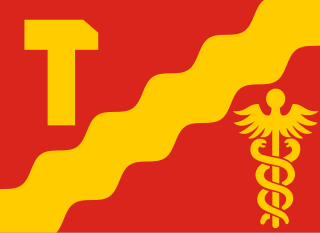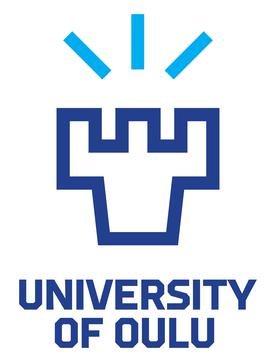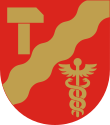The University of Southern Denmark has campuses located in Southern Denmark and on Zealand. It offers a number of joint programmes in co-operation with the University of Flensburg and the University of Kiel. Contacts with regional industries and the international scientific community are strong.

Tampere is a city in Finland and the regional capital of Pirkanmaa. It is located in the Finnish Lakeland. The population of Tampere is approximately 259,000, while the metropolitan area has a population of approximately 421,000. It is the 3rd most populous municipality in Finland, and the second most populous urban area in the country after the Helsinki metropolitan area.

The University of Helsinki is a public university in Helsinki, Finland. The university was founded in Turku in 1640 as the Royal Academy of Åbo under the Swedish Empire, and moved to Helsinki in 1828 under the sponsorship of Tsar Alexander I. The University of Helsinki is the oldest and largest university in Finland with the widest range of disciplines available. In 2022, around 31,000 students were enrolled in the degree programs of the university spread across 11 faculties and 11 research institutes.
Tampere University of Technology (TUT) was Finland's second-largest university in engineering sciences. The university was located in Hervanta, a suburb of Tampere. It was merged with the University of Tampere to create the new Tampere University on 1 January 2019.

The University of Jyväskylä is a research university in Jyväskylä, Finland. It has its origins in the first Finnish-speaking Teacher Training College, founded in 1863. Around 14,000 students are currently enrolled in the degree programs of the university.

The University of Oulu is one of the largest universities in Finland, located in the city of Oulu. It was founded on July 8, 1958. The university has around 13,000 students and 2,900 staff. 21 International Master's Programmes are offered at the university. The university is often ranked as one of the best universities in Finland and in the top 400 worldwide.

The University of Turku is a multidisciplinary public university with eight faculties located in the city of Turku in southwestern Finland. The university also has campuses in Rauma and Pori and research stations in Kevo and Själö.

The Singapore Management University (SMU) is a publicly-funded private university in Singapore. Founded in 2000, SMU is the third oldest autonomous university in the country, modelling its education after the Wharton School. The university is triple accredited by AACSB, EQUIS and AMBA. In 2024, SMU was ranked 44th in the world for Business and Management Studies, while also placing in the top 100 for Economics and Finance by QS.

Aalto University School of Arts, Design and Architecture; Finnish: Aalto-yliopiston taiteiden ja suunnittelun korkeakoulu; Swedish: Aalto-universitetets högskola för konst, design och arkitektur), was formed of two separate schools: the faculty of architecture and the University of Art and Design Helsinki. TaiK, founded in 1871, was the largest art university in the Nordic countries. The university awards the following academic degrees: Bachelor of Science in Technology, Architect, Bachelor of Arts, Master of Arts, and Doctor of Arts.
Tampere University is a multidisclipinary public university located in the city of Tampere, Finland. It is the second largest university in the country by student enrollment.

The University of Eastern Finland is a university in Finland founded in 2010 with campuses in Joensuu and Kuopio.

University of Kashmir (UoK), informally known as Kashmir University (KU), is a collegiate public state university located in the Hazratbal neighbourhood, on the western side of Dal Lake in the city of Srinagar, in Jammu and Kashmir, India, which was established in 1948.

Aalto University is a public research university located in Espoo, Finland. It was established in 2010 as a merger of three major Finnish universities: the Helsinki University of Technology, the Helsinki School of Economics and the University of Art and Design Helsinki. The close collaboration between the scientific, business and arts communities is intended to foster multi-disciplinary education and research.

The Tampere light rail, branded as Tampere Tram, is a public transport system in Tampere, Finland. In November 2016, the Tampere city council approved plans to construct a 330-million-euro light rail system on the route from the city centre to Hervanta and to the Tampere University Hospital. Traffic on the first two lines of the route began on 9 August 2021.
The Police University College is a university of applied sciences in Tampere, Finland providing police academy training and research under the Ministry of the Interior for the Police of Finland and other Finnish law enforcement units.

Nokia Arena, also known by its non-sponsored name Tampere Deck Arena, is an indoor arena in Tampere, Finland, which hosts ice hockey games and large cultural events. It is the home arena of Ilves and Tappara of the SM-liiga. Its construction was approved by the City Council of Tampere on 19 May 2010, and it was officially opened on 3 December 2021.

Tampere University of Applied Sciences is a university of applied sciences in the region of Pirkanmaa, Finland. Together with Tampere University, they constitute the Tampere higher education community.
Tampere Vocational College Tredu is a vocational college based in Tampere, Finland. It is part of the Tampere Upper Secondary Education and offers study vocational programmes in Finnish secondary education. In 2013, Pirkanmaa Educational Consortium and Tampere College united to become Tampere Vocational College Tredu. It offers more than 100 programmes in seven out of eight vocational education sectors which exist in the Finnish vocational education standards:

Yrjö Oskar Ruutu was a Finnish social scientist and politician. Ruutu was the first principal of the School of Social Sciences 1925–1932, 1935–1945 and 1949–1953, and the first Finnish professor of International relations 1949–1954. Ruutu was the first in Finland to defend his doctoral thesis on social sciences and wrote the first Finnish presentation on international relations as a science. He was also the head of the National Board of Education 1945–1950.

The Tampere Police Station is a police station located in the Ratina district in Tampere, Finland, and also the administrative center of the Central Finland Police Department. The police station is also used by the Finnish Security Intelligence Service (SUPO). There are about 400 police officers working there and about 50 others. The police station consists of two buildings located near the Tampere Bus Station along the Hatanpää Highway and Sorinkatu streets; due to this, in Tampere colloquially, the police station and its surroundings are also known as Sori by locals.
















